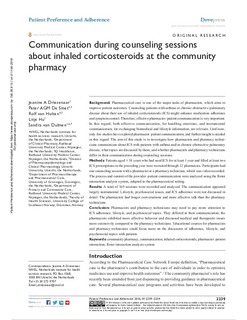| dc.description.abstract | Background Pharmaceutical care is one of the major tasks of pharmacists, which aims to improve patient outcomes. Counseling patients with asthma or chronic obstructive pulmonary disease about their use of inhaled corticosteroids (ICS) might enhance medication adherence and symptom control. Therefore, effective pharmacist–patient communication is very important. In this regard, both affective communication, for handling emotions, and instrumental communication, for exchanging biomedical and lifestyle information, are relevant. Until now, only few studies have explored pharmacist–patient communication, and further insight is needed in this regard. The aim of this study is to investigate how pharmacists and pharmacy technicians communicate about ICS with patients with asthma and/or chronic obstructive pulmonary disease, what topics are discussed by them, and whether pharmacists and pharmacy technicians differ in their communication during counseling sessions. Methods Patients aged ≥18 years who had used ICS for at least 1 year and filled at least two ICS prescriptions in the preceding year were recruited through 12 pharmacies. Participants had one counseling session with a pharmacist or a pharmacy technician, which was video-recorded. The process and content of the provider–patient communication were analyzed using the Roter interaction analysis system, adapted to the pharmaceutical setting. Results A total of 169 sessions were recorded and analyzed. The communication appeared largely instrumental. Lifestyle, psychosocial issues, and ICS adherence were not discussed in detail. The pharmacists had longer conversations and more affective talk than the pharmacy technicians. Conclusion Pharmacists and pharmacy technicians may need to pay more attention to ICS adherence, lifestyle, and psychosocial topics. They differed in their communication; the pharmacists exhibited more affective behavior and discussed medical and therapeutic issues more extensively compared to the pharmacy technicians. Educational courses for pharmacists and pharmacy technicians could focus more on the discussion of adherence, lifestyle, and psychosocial topics with patients. | |

